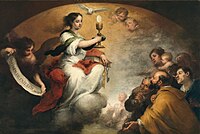
Back Pous Pius V Afrikaans بيوس الخامس Arabic بيوس الخامس ARZ Пій V Byelorussian Піюс V (папа рымскі) BE-X-OLD Пий V Bulgarian Pi V Breton Papa Pio V BS Pius V Catalan Gáu-huòng Pius 5-sié CDO
Pius V | |
|---|---|
| Bishop of Rome | |
 Portrait by Bartolomeo Passarotti, 1566 | |
| Church | Catholic Church |
| Papacy began | 7 January 1566 |
| Papacy ended | 1 May 1572 |
| Predecessor | Pius IV |
| Successor | Gregory XIII |
| Previous post(s) |
|
| Orders | |
| Ordination | 1528 by Oliviero Carafa |
| Consecration | 14 September 1556 by Giovanni Michele Saraceni |
| Created cardinal | 15 March 1557 by Paul IV |
| Personal details | |
| Born | Antonio Ghislieri 17 January 1504 |
| Died | 1 May 1572 (aged 68) Rome, Papal States |
| Motto | Utinam dirigantur viæ meæ ad custodiendas justificationes tuas ("O that my ways may be directed to keep thy justifications")[1] |
| Signature | |
| Coat of arms |  |
| Sainthood | |
| Feast day | 30 April |
| Venerated in | Catholic Church |
| Beatified | 1 May 1672 Saint Peter's Basilica, Papal States by Pope Clement X |
| Canonized | 22 May 1712 Saint Peter's Basilica, Papal States by Pope Clement XI |
| Attributes | |
| Patronage |
|
| Other popes named Pius | |
| Papal styles of Pope Pius V | |
|---|---|
 | |
| Reference style | His Holiness |
| Spoken style | Your Holiness |
| Religious style | Holy Father |
| Posthumous style | None |
| Part of a series on |
| Catholic Counter-Reformation |
|---|
 |
| Catholic Reformation and Revival |
Pope Pius V, OP (Italian: Pio V; 17 January 1504 – 1 May 1572), born Antonio Ghislieri (from 1518 called Michele Ghislieri), was head of the Catholic Church and ruler of the Papal States from 7 January 1566 to his death, in May 1572. He is venerated as a saint of the Catholic Church.[2] He is chiefly notable for his role in the Council of Trent, the Counter-Reformation, and the standardization of the Roman Rite within the Latin Church, known as the Tridentine mass. Pius V declared Thomas Aquinas a Doctor of the Church.[3][4]
As a cardinal, Ghislieri gained a reputation for putting orthodoxy before personalities, prosecuting eight French bishops for heresy. He also stood firm against nepotism, rebuking his predecessor Pope Pius IV to his face when he wanted to make a 13-year-old member of his family a cardinal and subsidize a nephew from the papal treasury.[5]
By means of the papal bull of 1570, Regnans in Excelsis, Pius V excommunicated Elizabeth I of England for heresy and persecution of English Catholics during her reign. He also arranged the formation of the Holy League, an alliance of Catholic states to combat the advancement of the Ottoman Empire in Eastern Europe. Although outnumbered, the Holy League famously defeated the Ottomans at the Battle of Lepanto in 1571. Pius V attributed the victory to the intercession of the Blessed Virgin Mary and instituted the feast of Our Lady of Victory.[6] Biographers report that as the Battle of Lepanto ended, Pius rose and went over to a window, where he stood gazing toward the East. "...[L]ooking at the sky, he cried out, 'A truce to business; our great task at present is to thank God for the victory which He has just given the Christian army'."[5]
- ^ Canonici regolari di sant'Agostino : Congregazione del santissimo Salvatore (1730). Bullarium Canonicorum regularium Rhenanæ congregationis sanctissimi Salvatoris, seu Congeries privilegiorum ab Apostolica Sancta Sede, & ab episcopis eisdem concessorum: item decreta sacrarum congregationum, aliorumque tribunalium declarationes in ipsorum favorem emanata, cuncta in duas partes divisa ... Opus utile, non modò præfatæ, sed etiam aliis canonicorum regularium congregationibus, quod eidem sanctissimo domino nostro Benedicto 13. pontifici maximo consecrat domnus Apollonius Lupi abbas generalis eorundem canonicorum regularium, & episcopus Himeriensis: Secunda pars privilegiorum sub titulo oneroso, necnon declarationum, cum indice in fine. typographia Reverendæ Cameræ apostolicæ. p. 87.R.P.D. Thomae Del Bene clerici regularis, ... De officio S. Inquisitionis circa hæresim: cum bullis, tam veteribus, quam recentioribus, ad eandem materiam, seu ad idem officium spectantibus; & locis theologicis in ordine ad qualificandas propositiones, pars prior \-posterior!, synopsi materiarum, et indice rerum, notabilium in hoc volumine contentarum illustrata. 1680. p. 665."Ps 118:5 VULGATE;DRA - utinam dirigantur viae meae ad - Bible Gateway". Bible Gateway. Retrieved 17 March 2016.
- ^ Durant, William 'Will'; Durant, Ethel 'Ariel' (1961), Age of Reason Begins, The Story of Civilisation, vol. 7, Simon & Schuster, pp. 238–39
- ^ Thomas Aquinas (1911). The "Summa Theologica" of St. Thomas Aquinas. Vol. 1. New York: Benziger Brothers. pp. xxxvi.
- ^ Jan Peil; Irene van Staveren, eds. (1 January 2009). Handbook of Economics and Ethics. Northampton, Massachusetts and Cheltenham, United Kingdom: Edward Elgar Publishing. p. 8. ISBN 978-1-84542-936-2.
- ^ a b Lataste, Joseph. "Pope St. Pius V." The Catholic Encyclopedia Vol. 12. New York: Robert Appleton Company, 1911. 18 July 2016
- ^ Aimé Georges Martimort, ed. (1986). The Church at Prayer: The Liturgy and Time. Vol. 4. p. 145. ISBN 978-0-8146-1366-5.